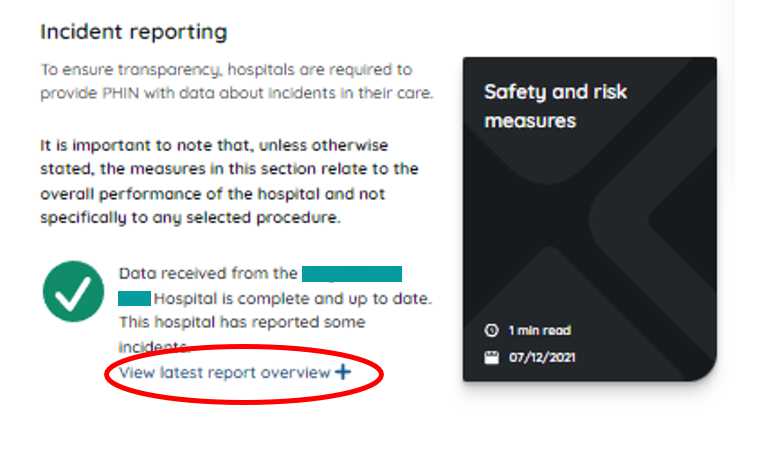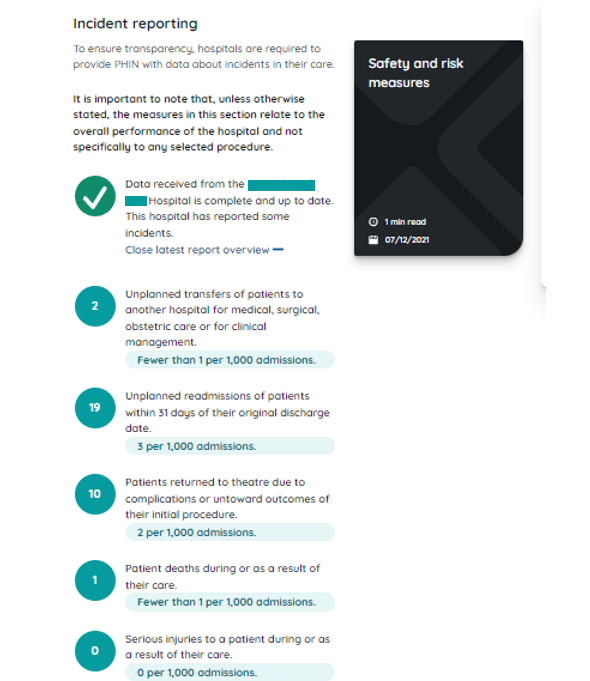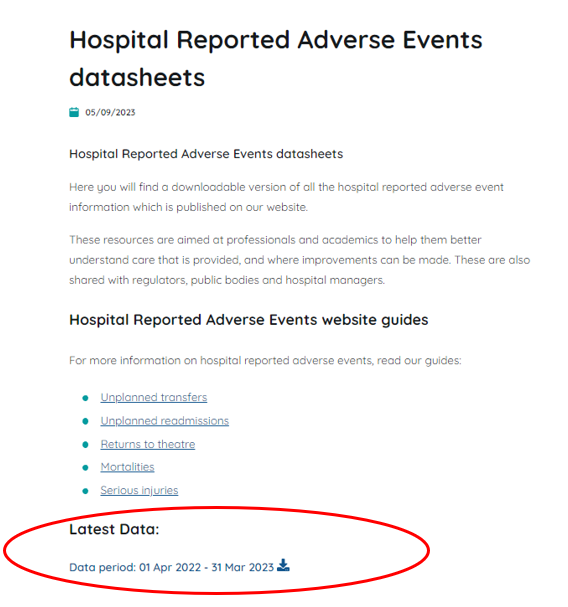Hospital-reported Adverse Events is one of several measures we publish on our website. These are designed to help people looking for a hospital or consultant doctor to diagnose or treat a health condition.
What are Hospital-reported Adverse Events (HRAEs)?
Hospital-reported Adverse Events (HRAEs) are events that have occurred during a patient’s private hospital admission and may have resulted in avoidable harm. HRAEs are collected from hospitals by self-declaration. This means that hospitals are responsible for reporting HRAEs that occur in their care. PHIN publishes five HRAEs:
1. Mortality (MOR)
Mortality is when a patient dies while they are in hospital or very soon after they were discharged.
2. Return to theatre (RTT)
A ‘return to theatre’ is when a patient has to be unexpectedly taken back into the operating theatre after their procedure has been completed and they are in recovery.
3. Serious Injury (SIJ)
A ‘Serious Injury’ is where a patient suffers a personal injury related to their treatment which has resulted in significant harm and reduction in quality of life.
4. Unplanned readmissions (UPRs)
An ‘unplanned readmission’ is when a patient who has been treated has to return to the same hospital as an emergency for a problem related to their original treatment. This must be within 31 days of being discharged.
5. Unplanned transfers (UPTs)
An unplanned transfer is when a patient is transferred from their current hospital to a different hospital and is not planned on admission to hospital. This could be to either the NHS or another private hospital.
How are hospital-reported Adverse Events measures published?
The measures are published at hospital site level on our website.
PHIN only publishes events where we can confirm that they relate to private patients. Where this is not possible we will still investigate the event in collaboration with the providers to which they relate.
For each Reporting Period HRAEs are presented as:
- A count (as reported by the provider).
- A rate, being the count per one thousand patient discharges (where the count of patient discharges equals the count of discharged spells occurring during the Reporting Period).
- The discharges applied as the denominator will vary by HRAE type:
o MOR and SIJ – all discharges
o UPR and UPT – all live discharges (exclude deaths)
o RTT – all discharges which include at least one procedure code - A published event has occurred within 12-months of the current Publication Period (a rolling-three-month period, published in March, June, September and December).
The data can be viewed by going to a hospital profile (using the search tool on the homepage or top of every page) and scrolling down to ‘Incident reporting’ and clicking on ‘View latest report overview’:

You will then be able to see the number of each types of event, and the number per thousand which can be helpful when comparing hospitals (though it’s important to be aware that hospitals may have reasons for a higher rate, such as accepting patients with more complex needs).

Datasheet
In addition to the information published on the hospital profiles, more detailed information is included in the Our data section.
The Hospital Report Adverse Events datasheets include counts and rates at country (based on the sites’ physical location) and national level (the aggregation of countries). It can be downloaded from the Hospital Report Adverse Events datasheets page. Each type of event has a separate tab at the bottom of the spreadsheet.

Why should I be interested in information about HRAEs?
HRAEs can offer a comprehensive measure of patient safety within a hospital. They cover a variety of different events, including both serious and minor incidents. PHIN collects these from a range of hospitals in the UK. However, there are some limitations to using HRAEs to measure patient safety.
These events are self-reported by hospitals and may not capture all incidents of patient harm. They may be affected by reporting bias. HRAEs are only a snapshot and do not provide the root cause of an incident, or about the interventions since the event to improve safety.
Because of these and other factors, these infection measures alone, published on PHIN’s website and elsewhere, can’t tell you the full story of an individual patient’s risk of experiencing an Adverse Event at a particular hospital. Therefore, this information is best used as part of the wider discussions about patient safety and care with your consultant or hospital.
Help with understanding and using our healthcare datasheets
Find out more about our data sheets, including how we protect patient data.
Go to Datasheets.
